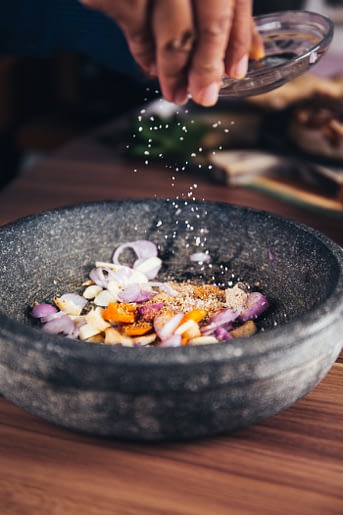There are many ways to use spices to enhance the foods you cook. Next time you walk down the spice aisle, you’ll have a better idea of what spices to use and how to use them with this guide on how to use spices effectively.
Why Use Spices for Cooking?

Using spices for cooking may seem like an obvious choice for those who already know how to cook, but for newbies to the cooking world here are some reasons to use spices for cooking:
To add instant flavor and taste to a meal
The best things in life should always have a bit of flavor and taste (especially food). Your favorite meals are likely packed with an abundance of different tastes that you remember long after your meal or dish is eaten.
To define cultural cuisine such as Indian, Mediterranean, Cajun, Middle-Eastern etc.
Each culture has its own spices that make its cuisine unique and tasteful. If you’d like to try cooking recipes from other countries and cultures, you’ll need to know which spices and flavors match the traditional dishes for truly authentic flavor.
There are added health benefits that come from using spices
Many spices have health benefits that your body will love. For example, turmeric is known to have anti-inflammatory properties that may help with joint stiffness, pain, and inflammation.
Read more about the health benefits of spices here.
They make food look appealing
Many spices add color and texture to foods, thereby making them look beautiful as well as appetizing.
Which Spices Are Best for Beginners?
Spices need to be used with care, especially since some combinations of spices do not complement each other. Here are some spices you can start cooking with as a beginner:
Ground Garlic Powder

Garlic powder is a less dominant flavor profile than fresh garlic cloves. Unlike fresh garlic cloves, garlic powder has an excellent shelf life and does not overpower the other flavors in a dish. Garlic powder is most commonly used to season foods such as vegetables, meats of all kinds, potatoes, pasta, and pizza.
Turmeric
Turmeric is a golden super spice. It originates from India and has an earthy, musky, and peppery flavor. It tastes great in soups, stews, rice, and even teas.
It also has great healing benefits as mentioned above.
Cumin
This spice is a warm, slightly sweet, and nutty spice that is often used as a savory alternative to cinnamon. It is often used in Latin, North American, North African, and Indian cuisines. Cumin works well in foods such as chili, soup, baked beans, and barbecue sauce.
Smoked Paprika
Parika is made out of smoked peppers and has a deliciously rich and smoky flavor. The first paprika was produced in Spain and ranges from sweet to mild to hot.
Use paprika with deviled eggs, hummus, and waffle fries.
Crushed red pepper flakes
Crushed red pepper flakes are a must in every kitchen. This spice is made out of dried chili peppers, which adds mild heat to foods.
Crushed red pepper flakes can be used in almost any dish to add a bit of a kick. Try using it in some mac and cheese to bring some spice to it.
Oregano
Oregano is a bold herb with a peppery, sweet, and almost minty flavor. Oregano is often used in Greek and Italian dishes, but it can bring an amazing flavor profile to a variety of foods.
How to Use Spices Effectively
Here are some key ways to use spices correctly in your cooking:
1. Learn Your Spices by Type
Spices can be divided into two main types: whole and ground. Consider that each type brings something different to the dish.
Whole spices add flavor and aroma, while ground spices add color and taste.
2. Know They Change Form When You Cook
Not all spices have the same taste or consistency when you cook them (depending on how they are cooked and for how long).
For instance, if cumin seeds are roasted and ground, they add a fresh, woody, and sharp flavor to a dish. If they are in powder form, then cumin is more spicy and pungent.
3. Consider How They Pair and Combine With Food and Other Herbs and Spices
Identify the taste and classification of the spices and herbs you’ll use when you cook. Try using a taste classification spice chart to help you combine the right spices at the beginning of your culinary journey.
4. Less is More
Adding a bunch of different spices to a dish without measuring them properly doesn’t equal a great-tasting dish. Spices need to be balanced with the flavor profiles of the food you’re seasoning.
Begin with small amounts of spice. 1 tsp or ½ teaspoon of spices is a good measurement to start with when cooking with spices as a beginner.
A List of Chef Nigel’s Favorite Spices to Cook With

Chef Nigel knows how to combine the best flavors and spices to make a variety of gourmet cuisines from around the globe.
Here are some of the spices he uses in his signature dishes:
- Ground Sage
- Nutmeg
- Ground Ginger
- Allspice
- Garam Masala
- Curry Powder
Want to taste some of Chef Nigel’s meals? Book him now for your next dinner party or event in NYC.


dating single
searchingforsingles
free dating websites singles
online free dating service
our time dating service
meet women locally